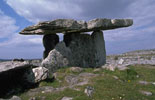Guided One-Day Trip
15 Sep 2005
Price: €35 per person (lunch is not included).
The trip will be guided by Tony Kirby from Heart of Burren Walks. We will departure from the UL campus early in the morning on the 15th of September to meet Tony in Ennis. We will return to the UL campus in the early evening.
Note: We can take up to 45 people on the trip. The seats on the coach will be sold on a first come, first served basis. If you would like to join the trip please make sure you include it when you register for the conference.
Depending on the weather conditions etc., the itinerary will be something along the lines below:
Morning
-
Visit The Great Famine monument between Lahinch and Ennistymon - opposite the site of the Ennistymon workhouse.

-
Visit St Bridget's Holy Well between Liscannor and the Cliffs. Holy wells circa 3,000 in Ireland all formerly pagan sites.
-
Visit the Cliffs of Moher - some of most dramatic sea cliffs in Europe - 8 km long and 210 m high - drama lies in their sheer verticality. Home to vast colonies of seabirds such as guillemots, razorbills and puffins.
-
Enter the Burren via Lisdoonvarna - visit Ballyryan - an area of international significance ecologically which boasts flowers from the Mediterranean, Alpine and Arctic regions growing happily together side by side.
-
Proceed to Ballyvaughan via spectacular coastal drive around Black Head.
-
Stop in Ballyvaughan for lunch.
Afternoon
-
Travel main north south interior road of Burren - boasting a very high concentration of archaeology and some classic natural features of a karstic landscape.

-
Visit the magnificent early Christian earthen fort An Ráth in Ballyvaughan valley.
-
Visit also the stone fort Cathar Mhór.
-
See field where Gleninsheen gold collar (Bronze Age) was found and also view Gleninsheen wedge tomb therein.
-
Visit Poulnabrone dolmen - 600 year old chambered tomb - the archaeological icon of the Burren.
-
Stop at Leamaneh Castle at the interface between the Burren and the outside world - a singular attachment of a Renaissance mansion to an earlier medieval towerhouse.